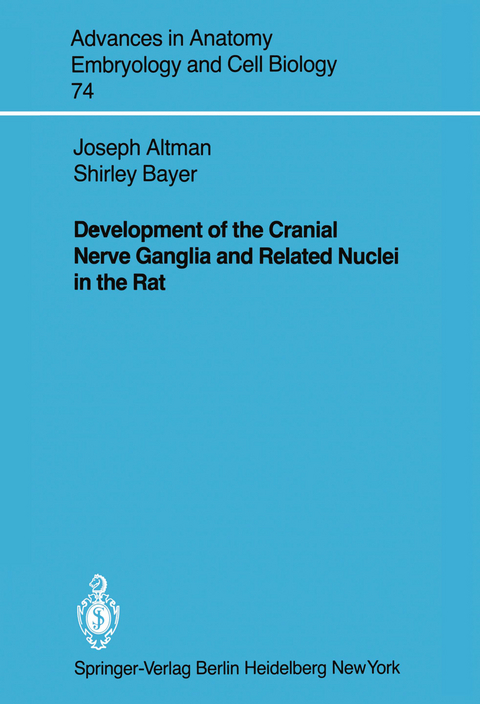
Development of the Cranial Nerve Ganglia and Related Nuclei in the Rat
Springer Berlin (Verlag)
978-3-540-11337-9 (ISBN)
1 Introduction.- 2 Materials and Methods.- 2.1 Whole-Body Thymidine Radiograms.- 2.2 Paraffin- and Methacrylate-Embedded Embryos.- 3 Development of the Trigeminal Ganglion in Relation to the Trigeminal Nuclei.- 3.1 Time of Origin of Trigeminal Ganglion Cells.- 3.2 Fate of the Two Components of the Trigeminal Anlage.- 3.3 Development of the Trigeminal Nuclei of the Upper Medulla.- 4 Development of the Facial Ganglion in Relation to the Facial Motor Nucleus.- 4.1 Time of Origin of Facial Ganglion Cells.- 4.2 Embryonic Development of the Facial Ganglion.- 4.3 Development of the Facial Motor Nucleus and Nerve.- 5 Development of the Vestibular Ganglion in Relation to the Vestibular Nuclei.- 5.1 Time of Origin of Vestibular Ganglion Cells.- 5.2 Embryonic Development of the Vestibular Ganglion.- 5.3 Embryonic Development of the Vestibular Nuclei.- 6 Development of the Glossopharyngeal and Vagal Ganglia in Relation to the Solitary and Ambiguus Nuclei.- 6.1 Time of Origin of Glossopharyngeal and Vagal Ganglion Cells.- 6.2 Embryonic Development of the Glosso pharyngeal and Vagal Ganglia.- 6.3 Development of some Medullary Nuclei Associated with the Glossopharyngeal and Vagal Nerves.- 7 An Aspect of the Development of the Hypoglossal Nucleus and Nerve.- 8 General Discussion.- 8.1 Sequence of Production of Motor Neurons, Ganglion Cells, and Sensory Neurons of the Cranial Nerves.- 8.2 Placodal Origin of Ganglion Cells.- 8.3 Nerve-Specific Boundary Caps and Their Possible Role in the Guidance of Afferents and Efferents.- 8.4 Sites of Neuron Production, Routes of Migration, and the Relation Between Cytogenetic Zones and Neuroepithelial Zones in the Medulla.- 9 Summary.- Abbreviations.- References.
| Erscheint lt. Verlag | 1.3.1982 |
|---|---|
| Reihe/Serie | Advances in Anatomy, Embryology and Cell Biology |
| Zusatzinfo | VIII, 92 p. 55 illus. |
| Verlagsort | Berlin |
| Sprache | englisch |
| Maße | 170 x 244 mm |
| Gewicht | 215 g |
| Themenwelt | Sachbuch/Ratgeber ► Natur / Technik ► Naturführer |
| Studium ► 1. Studienabschnitt (Vorklinik) ► Anatomie / Neuroanatomie | |
| Schlagworte | Development • Embryologie • Hirnnerv • nuclei • Rat |
| ISBN-10 | 3-540-11337-1 / 3540113371 |
| ISBN-13 | 978-3-540-11337-9 / 9783540113379 |
| Zustand | Neuware |
| Haben Sie eine Frage zum Produkt? |
aus dem Bereich


